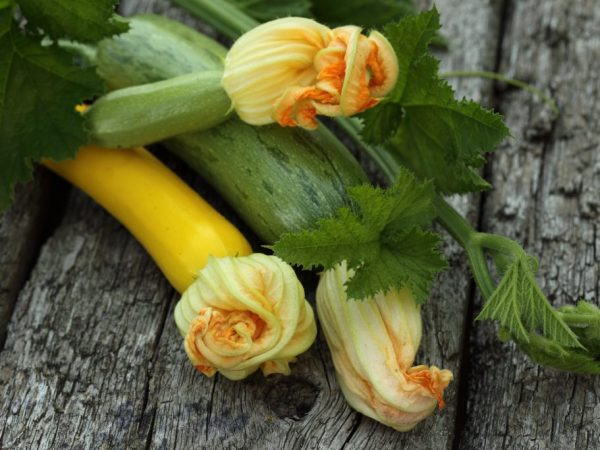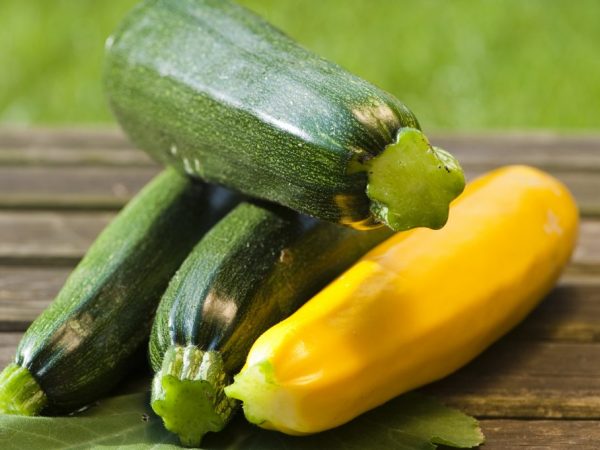The main differences between zucchini and zucchini
The trendy variety of zucchini competes with ordinary zucchini - more and more often it appears in recipes and on tables. These two vegetables are close relatives, and therefore very similar. But there is also a difference between zucchini and zucchini, which is useful for everyone who grows these vegetables to know about.

The main differences between zucchini and zucchini
Origin
The birthplace of zucchini is considered to be Mexico, from where they came to Europe in the 16th century. At that time, the nutritional and taste properties of these fruits were not yet appreciated. Only seeds were eaten (as in other pumpkin species).
The Italians were the first to guess to taste the pulp of an unripe zucchini, after which they gladly included it in the list of culinary products.
They also soon bred a new variety of pumpkin vegetable, crossing an ordinary squash with kruknek pumpkin. This is how the first zucchini appeared. From zucchini they took over the appearance, and from the crookneks - taste and nutritional properties. Both vegetables arrived in Russia only in the 19th century.
Beneficial features
Both vegetables are rich in vitamins and trace elements (potassium, sodium, iron), carotene and organic acids. However, zucchini contains much more vitamin C. Fiber and easy-to-digest carbohydrates contribute to digestion, normal metabolism, and cleansing the body of toxins.
Vegetables are low-calorie, and therefore welcome with any diet.
The calorie content of 100 g of zucchini is 24-26 kcal, and 100 g of zucchini is 17-20 kcal.
The fruits do not cause allergies, therefore, they are indicated for the first baby food, as well as for pregnant women. They are recommended to be included in the diet for diseases of the liver, kidneys, gallbladder, heart, circulatory system.
Vegetables create a good prevention of atherosclerosis and hypertension. Their regular use improves vision, dental health, hair and skin structure.
Appearance and taste
First of all, these vegetables differ in appearance. Zucchini has a green skin with or without dark stripes, but it can also be yellowish. Its cousin is usually pale green and much lighter in color.
The size of a squash can be compared to a good pumpkin if allowed to ripen and overripe. It has a thin and delicate skin. The pulp is denser.
The zucchini has a tougher skin, and the flesh is juicy and tender, the fruit does not exceed 25 cm in length, and it is recommended to pluck them even earlier - when they reach 15-18 cm.In addition, it looks very elegant, and its brother has a more rounded shape ...
Both of them are similar in taste, but, and squash - The seeds of the first are small, which allows you not to choose them when cooking. Squash seeds are much larger, which is especially evident in ripe fruits.
Agrotechnics

There are no differences in growing crops
In terms of growing, there is not much difference between zucchini and zucchini - you will have to do the same thing. Both species are thermophilic, prefer fertile soil, need abundant watering and good lighting. They can be killed by sudden frosts, acidic soils and lack of light.
However, there are also small differences that gardeners need to know:
- The fruits of the zucchini are small and compact.Therefore, the distance between the bushes can be saved. However, you can do the same for zucchini if you pick them young. But if you plan to leave the fruits for full ripening, the distance between the holes should be at least a meter.
- Both vegetables love warmth. For zucchini, a temperature of 20-25 ° C is acceptable, and for zucchini - 22-25 ° C. With a decrease of several degrees, the former will rise faster, and the latter will lag behind in growth. Therefore, additional heating of the soil will not prevent them - they can be planted in high beds or on heaps with a high content of compost.
- Zucchini is different in that it ripens faster. On the 8th day of ripening, it can already be plucked. In any case, the fruits should not outgrow the size of 15-17 cm. Young zucchini are harvested when they reach 15-20 cm, and specimens for storage or seeds are left in the garden until fully ripe.
- If we compare zucchini and zucchini of the same size, then the keeping quality of the first will be the best - it can be stored for a week in a cool and ventilated room. Young squash will only last a few days, but fully ripe can be stored for months.
How to use
The main difference is that zucchini can be eaten raw along with the skin. They are added to salads or eaten individually, chopped on a grater. For the rest, the cooking methods for both fruits are the same: they can be fried, stewed, boiled, pickled, baked. These vegetables work well with most foods and can add healthiness to any meal.
As for fully ripened and overripe zucchini, they are not so tasty when fried and baked, but they are quite suitable for cooking caviar. At the same time, their tough peel must be cut off, and large grains must be chosen.
In addition, dried zucchini seeds and zucchini flowers (for example, fried in breadcrumbs) are eaten.
Conclusion
Zucchini and zucchini are close relatives with very similar properties and characteristics. The peculiarities and differences of zucchini relate to its appearance, taste, ripening times and methods of consumption. It is more suitable for preparing a variety of dishes, but it cannot be stored for a long time, like fully ripened zucchini.

